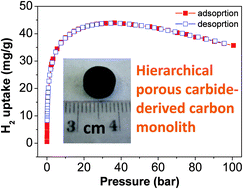Hierarchical porous carbide-derived carbon monoliths (HPCDCM) were prepared by selective extraction of silicon from ordered mesoporous silicon carbide monoliths (OMSCM) through chlorination at high temperature. The OMSCM was firstly synthesized by pressure-assisted nanocasting procedure using KIT-6 silica as the hard template and polycarbosilane (PCS-800) as the preceramic precursor. The OMSCM showed cubic ordered mesoporous structure with specific surface area of over 600 m2 g−1. After the chlorination, the resulting HPCDCM demonstrated very high specific surface area (2933 m2 g−1), large pore volume (2.101 cm3 g−1) with large volume of micropores (0.981 cm3 g−1), and narrow dual pore size distributions (micropore: 0.9 nm, and mesopore: 3.1 nm). Macropores in the micron range were observed in the HPCDCM. The mesostructural ordering was not maintained in the HPCDCM and the volume of the HPCDCM had greatly shrunk, by 21.2% compared to that of the OMSCM, but the tablet-like appearance was well retained in the HPCDCM. At −196 °C, the HPCDCM shows good hydrogen uptakes of 2.4 wt% and 4.4 wt% at 1 bar and 36 bar, respectively. The calculated volumetric hydrogen storage capacity is 11.6 g L−1 at 36 bar. The gravimetric hydrogen uptake capacity of the HPCDCM is comparable to, or higher than, those of previously reported ordered mesoporous carbide-derived carbon (CDC) powder and microporous CDC powder.

